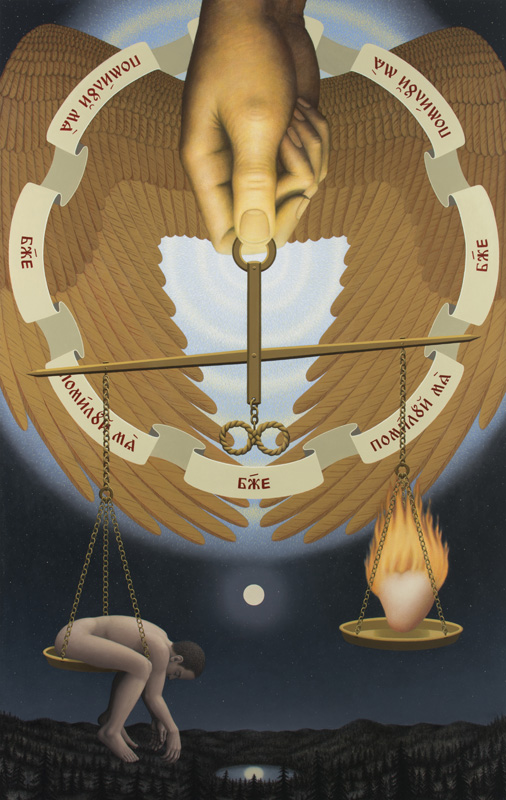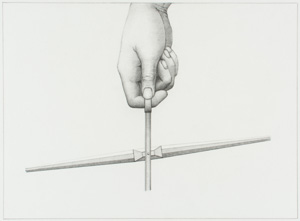
 |
| Weighing of Souls 2015, acrylic on canvas 76 x 48 in. |
Weighing of Souls |
The initial impetus for Weighing of Souls was to revisit the theme of the physical manifestation of God through the image of an oversized hand I first used in my 2001 painting, Misericordia. In that piece I focused on the idea of a compassionate God carrying a figure from the entanglements of an earthly existence to the heavens above. In Weighing of Souls I decided to shift the focus from a compassionate to a judgmental God depicted as an oversized hand holding a weighing scale with a figure on one side being judged against a burning sacred heart on the other. |
 2001, acrylic on canvas, 66 x 48 in. |
 2015, acrylic on canvas, 76 x 48 in. |
One interesting characteristic of Weighing of Souls is the relationship between the otherworldly section that dominates the upper half of the canvas and the real world section below. One aspect of this relationship is how each section affects the proportional size of the other. That is, the real world section makes the otherworldly section seem large, almost colossal, while conversely the otherworldly section makes the real world seem diminutive. Another aspect of the relationship is that the otherworldly section feels light and airy because it is rendered in light tones of blue, gold and ivory, whereas the real world section feels leaden and foreboding because it is rendered in dark tones of blue, gray, and black. And when these two aspects are combined the otherworldly section exudes a sense of spirituality and transcendence that is absent from the real world below. Another interesting characteristic of the painting is the structure of the otherworldly section. It is essentially circular in shape with two large golden wings and a long stylized ribbon set against a blue circular background that radiates waves of light from the center. The hand of God dramatically enters the circle from above holding a large weighing scale. The wings emanate from behind the hand and arch down and inward mimicking the circular structure as the ribbon floats on top of them. The text on the ribbon is another interesting characteristic of the piece. It is written in Church Slavonic, the liturgical language used by the Russian Orthodox Church, and translates as "have mercy on me, O God". I first became aware of the language when listening to Arvo Part's Kanon Pokajanen, a wonderful choral work about repentance. Though the Church Slavonic text is not readable to most of us, in the context of Weighing of Souls it not only takes on a visually dynamic presence it also lends a sense of mystery. Compositionally the Weighing of Souls follows my usual choice of symmetry with a few symmetrical departures to help add to the work's visual interest. Two examples of these symmetrical departures can be seen in the placement of the figure on one side and the sacred heart on the other, and the dynamic topography and forestation of the landscape. To add to the visual interest I have also structured a vertical alignment of focal elements down the center of the canvas. From top to bottom these include the thumb of the large hand; the circular ring, vertical bar and eternity symbol of the scale; the Church Slavonic text for God on the ribbon; the glowing moon; and the lake with the moon's reflection. This alignment also helps connect the spirituality of the otherworldly section to the physicality of the real world. |
 2005, graphite on paper, 7 7/8 x 10 3/4 in. |
 2008, graphite and acrylic on paper, 13 x 8 in. |
As I look back on the creation of Weighing of Souls in context with the drawings I did in preparation for the painting, I am struck by the duration of time between the execution of the first sketches (2005), the finished drawing (2008) and the painting (2015). During those ten years I was of course occupied with other works, but the time between them made me realize that this gestation period as it were has become an important factor in the creation of my work. - Brian Mains, January 2019 |